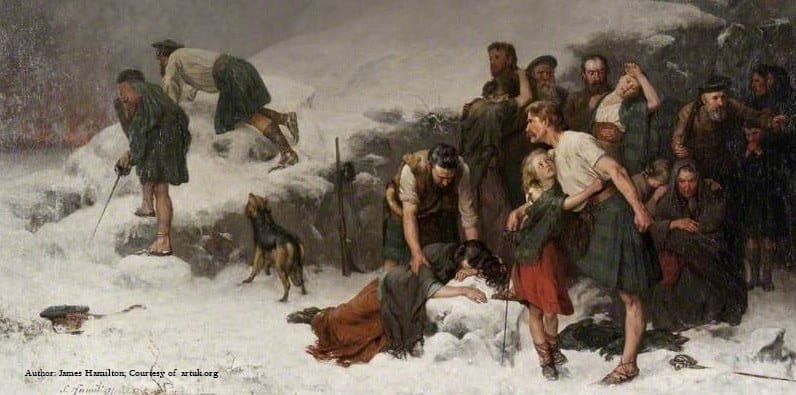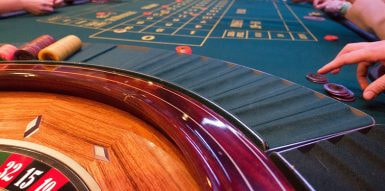Related History and Myths
Many theories are explaining why the nine of diamonds is called The Curse of Scotland. Although they have a greatly varying degree of plausibility, there’s one thing that unites them. All suggested explanations are based on actual events that took place in the Restoration period and the Georgian era. Here are the most spread narratives around the Curse of Scotland phrase:
- Sir John Dalrymple allegedly wrote the order for the Glencoe Massacre on a nine of diamonds playing card.
- The No Quarter order the Duke of Cumberland gave before the Battle of Culloden was supposedly inscribed on a nine of diamonds card.
- The role of the nine of diamonds in the games Pope Joan and Comette, plus the historical references related to these games, gave the card’s dark nickname.
- The diamond is a royal symbol and nine refers to the reigns of tyrannical monarchs.
- A severe tax was levied on the people of Scotland to repay for the theft of nine royal jewels.
- The phrase is a corruption of the original “Cross of Scotland” that derived from the card’s resemblance with St. Andrews saltire.
Although these stories reflect the context of the time, the lack of supporting documents and the obvious anachronisms dismiss many of them as myths. In the following paragraphs, you’ll find more details about each version and its supporting sources.
John Dalrymple and the Glencoe Massacre
We’ll start with our favourite story that revolves around the personality and the work of Sir John Dalrymple, 1st Earl of Stair. Dalrymple was a skilful and powerful politician who supported an agenda that directly contradicted the Scottish cause. Serving as a Joint Secretary of State in Scotland between 1691 and 1695, he vigorously pursued the unification of Scotland and England and was the main force behind the passing of the Act of Union. Ironically, he didn’t live long enough to see the result of his work. The treaty which commenced in May 1707, was agreed upon during voting in the Scottish Parliament just a few days after the Earl Stair’s death in January the same year.
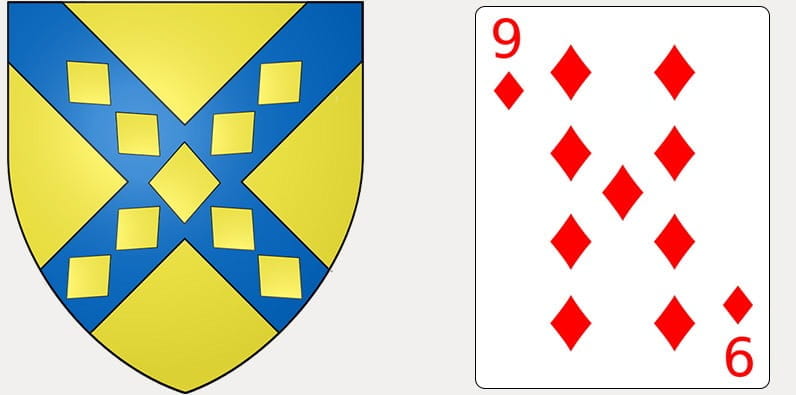
In addition to his political pursuits, Dalrymple became notorious for authorising the Glencoe Massacre which took place on 13 February 1692. After the Jacobite uprising of 1689-92 failed to reinstate James II of England and VII of Scotland on the throne, the new monarch, William III of England and II of Scotland, granted a royal pardon to all Scottish clans who swore allegiance to him and his wife. Those who refused did so at the risk of imminent retribution. Since true Scottish loyalty to the English crown was questionable, it was believed that a painful example must be given by punishing one of the clans. The government in the face of Dalrymple targeted the Glencoe McDonalds for their history of lawlessness. In the night of 13 February, 1692 army forces attacked the MacDonalds and slew 38 members of the clan. Some survivors fled to the mountain, but the severe weather added more to the death toll. It’s interesting to note that there was a conveniently strong presence in the army ranks of members of the Campbell clan. Known to be rivals with the MacDonalds for generations, the Campbells were tasked with the massacre. This act provided a good cover-up, and at first, the act looked like the next culmination of the interclan disputes, rather than a cunningly executed government plot.
So, how does the nine of diamonds fit in these stories of blood and vengeance? First, it is believed that the Earl Stair wrote the order for the Glencoe Massacre on such a card. Which must be dismissed as an obvious myth because the actual written order still exists and is relatively well preserved. Sir John Dalrymple was forced to resign from the position of State Secretary due to the public outcry following the events at Glencoe. Nevertheless, his involvement in this bloodbath in addition to his support for the Act of Union made him very unpopular among the Scottish anti-unionists. The Stair’s coat of arms has a blue saltire with nine yellow diamonds ordered in a cross-shape, which resembles greatly the layout of the card nine of diamonds, which is supposedly the reason why the card is called the Curse of Scotland.
The Duke of Cumberland and the Battle of Culloden
There’s another historical figure that opposed and ruthlessly crashed the Jacobites. Prince William (1721-1765), Duke of Cumberland, played a crucial role in the decisive victory in the Battle of Culloden in 1746. This battle remained in history as the last one fought on British soil. It effectively ended the Jacobite uprising from 1745 known as the Forty-five Rebellion. In the evening before the Battle of Culloden, the Duke of Cumberland ordered his troops to show no quarter to the surviving enemy combatants, turning the victory into a merciless bloodbath. His brutality earned him the nickname Butcher Cumberland, given by his opponents. Also, as one story goes, William’s cruel order was inscribed on a nine of diamonds playing card, and therefore the card became known as the Curse of Scotland.
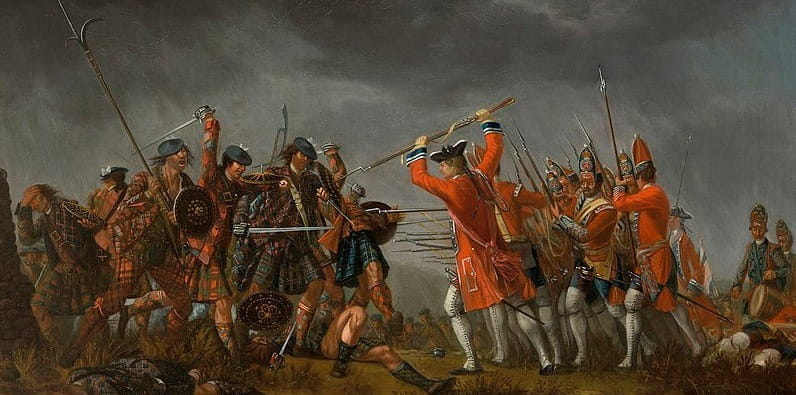
Despite the historical reference, this explanation cannot be accurate due to huge time mismatch. The earliest written mentioning of the Curse of Scotland dates back in 1708. It is found in the book “The British Apollo”. The Battle of Culloden took place 38 years later, meaning that the events of the Forty-five Rebellion did not inspire the famous saying.
Popular Card Games in the Old Times
E. Brewer’s “Dictionary of Phrase and Fable” mentions the historical references from above but outlines two other explanations as more plausible. Both versions suggest the origin of the proverb should be sought in card games which were popular in the past. The first suggestion is that the nine of diamonds had a special role in the 19th century game called “Pope Joan”. The game was particularly popular in Scotland and its very name is directly linked to Pope John VIII who was referred to by the Scottish reformers as the Antichrist. The card nine of diamonds was called the Pope, and due to the real pope’s infamy among the Scotts, it became known as the Curse of Scotland.
The second game Brewer refers to is a predecessor of Pope Joan called Comette. Introduction of the game to the Scottish royal court is attributed to Mary of Lorraine in the 16th century. The game became notorious for causing the bankruptcy of many nobles. The winning card was the nine of diamonds, and the many lives it ruined gave it the infamous nickname.
The Diamond as a Royal Symbol
“The British Apollo” says that royal regalia were usually ornamented with precious stones. Hence the diamond in the proverb should be considered nothing more than an allegory of the monarch. The book also claims that “…for Scotland’s Kings for many Ages, were observed, each Ninth to be a Tyrant…”. Historical records, however, indicate that kings who were a scourge to their land and folk reigned more frequently than one in nine generations.
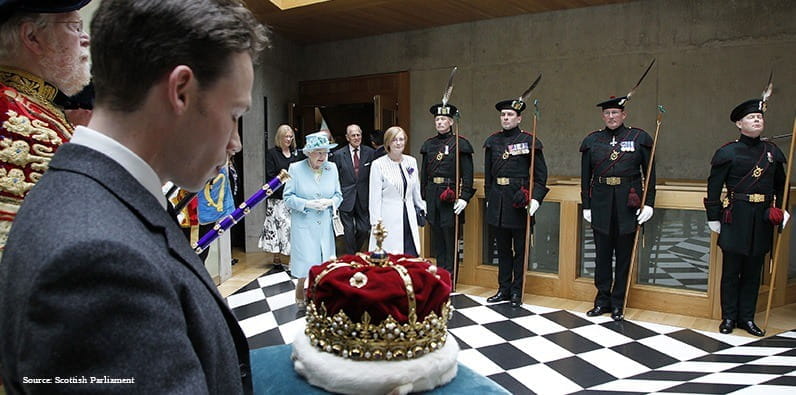 Source of the Image: Scottish Parliament
Source of the Image: Scottish Parliament
Another fictional story we came across says that the theft of nine diamonds from the Scottish Crown resulted in a harsh tax on the people who were punished by the monarch to repay for the missing jewels collectively. It is true that the entire set of royal regalia of Scotland disappeared for over a century at the time of the Union Treaty. However, there’s no record of the detachment of precious stones from the crown and subsequent taxes.
The last narrative we heard of concerning the royal jewels says that while most monarchs had crowns with ten diamonds, the Scotts could only afford nine stones. Which supposedly put the entire nation to shame. Just like the theft story, this one has no factual support.
Misinterpretation of Cross
Brewer’s “Dictionary of Phrase and Fable” notes the suggestion that the word “curse” could be simply a corruption of “cross”. The supposed similarity between St. Andrews Saltire and the cross-like shape the diamonds form on the card, gives a reason for calling the card the Cross of Scotland. However, this explanation is rejected by the author because St. Andrew’s cross is plain and doesn’t have lozenge ornaments. Therefore, any other suit of nine could represent the cross, and there’s no solid evidence to support the choice of the diamond.
The Blend of Facts and Myths
The earliest mentioning of the Curse of Scotland and the nine of diamonds is in the “British Apollo” published in 1708. The book proposes only one version – the one saying that every ninth monarch was a tyrant. As said above, the “Dictionary of Phrase and Fable” dismisses that as insubstantial. In another book, “The Scotsman’s Library; Being a Collection of Anecdotes and Facts”, the author claims that the orders for the Battle of Bothwell Bridge were written on a nine of diamonds card by the Duke of Monmouth. The story resembles a lot the narrative around the Battle of Culloden. While the events at Culloden (1746) took place 38 years after the first documented description of the phrase, the Battle of Bothwell Bridge (1679) was 29 years before “British Apollo” was printed. The timeline makes clearly Bothwell Bridge more plausible. However, this version wasn’t even mentioned in the rest of the sources we checked. The most detailed description of the proverb’s origin is given in “The Book of Days” (1864) and includes a wider collection of known versions. The Curse of Scotland is clarified in the chapter about John, First Earl of Stair. Dalrymple’s biography and family crest are given as primary reasons for proclaiming the nine of diamonds as the Curse of Scotland. As mentioned, Brewer denounces that later in 1898.
As illustrated above, none of the theories of the proverb’s origin is undoubtedly proven. However, the way some of the stories stem from actual events is intriguing. The historical context presents mainly dark and unfortunate moments from the Scottish past, marked by bloodshed and suffering. The phrase berhymes a national cause that was cruelly drowned in blood. Given the inconsistencies between the sources and the obvious inaccuracies in some of the narratives, we’d claim that the Curse of Scotland is more of an anecdotal phrase rather than a strict reference to a real person or event.
Here are the reference sources we used to prepare this article:
- “The British Apollo, or, Curious Amusements for the Ingenious”, Vol. 1, 1708;
- Brewer, E. Cobham, “Dictionary of Phrase and Fable”, Philadelphia: Henry Altemus, 1898; (e-version available here);
- Castelow, Ellen, “The Battle of Bothwell Bridge”, Historic UK;
- Castelow, Ellen, “The Battle of Culloden”, Historic UK;
- Chambers, Robert, “The Book of Days: A Miscellany of Popular Antiquities in Connection with the Calendar, Including Anecdote, Biography, & History, Curiosities of Literature and Oddities of Human Life and Character”, Vol. 1, W. & R. Chambers, 1864;
- Mitchell, James, “The Scotsman’s Library; Being a Collection of Anecdotes and Facts Illustrative of Scotland and Scotsmen”, J. Anderson jun., 1825;
- Murray Pittock, “7 myths about the battle of Culloden busted”, April 2018, History Extra;
- Battle of Culloden article, National Army Museum official website;
